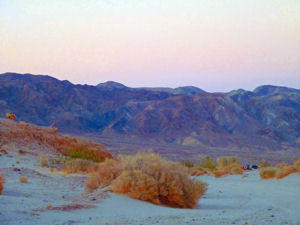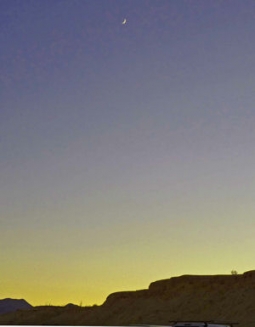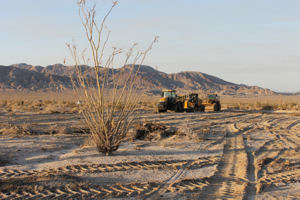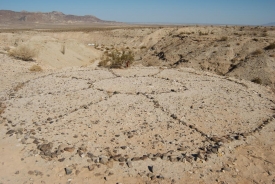By Miriam Raftery
June 24, 2012 -- A sliver of moon and a spangle of stars shone down on the Ocotillo desert last night, where representatives from eight tribal nations joined in ceremonies to honor their ancestors. Hundreds of people from across the southwestern U.S. came to mourn the desecration of Native American sacred lands, cremation sites and the natural environment that is now occurring on public land.
As twilight melted into darkness across the shifting sands and jagged ridgelines, the night’s silence was broken only by the whistling of the wind and the cadence of ancient Native American songs unchanged for the past 10,000 years. But that way of life—and the peaceful presence of this place--may soon be gone forever.
By day, bulldozers and heavy earth-moving equipment are destroying this fragile desert environment as construction moves relentlessly forward on Pattern Energy’s Ocotillo Express wind facility.
Barring a court order or some other action to stop the project, soon over 100 wind turbines each some 45 stories high--taller than the Statue of Liberty--will consume a desert that before was pristine. Lights to warn off air traffic will penetrate the night atop the towering turbines, each with a blade sweep wider than a football field.
Concrete foundations, each 50-feet wide by 8 feet deep or more, will occupy even more terrain and will remain here forever, even after the project may be decommission someday. There are also 42 miles of roads being built, power lines, a substation, and more.
Last night, the pungent aromas of burning sage and a wood campfire filled the air as one by one, leaders rose to voice their anguish over the disrespect shown to their ancestors. Many dressed in traditional attire, gathered beneath a hand-hewn ramada of branches, where items reflective of their culture and their ancestors were displayed.
The mood was not one of anger, but of dignified resolve—a determination to unite all Indian nations and the public to understand the magnitude of what is being lost.
"This is not a protest," Viejas Chairman Anthony Pico made clear. Instead, he called for all to come together in a time of "healing." Viejas was one of several bands of the Kumeyaay nation represented; other San Diego bands included Barona, Sycuan, and Manzanita. Some traveled from out of state, such as those from the Navajo nation.
Prayers were recited, followed by an all-night wake with ancient birdsongs and dancing to honor the generations of long ago whose consecrated ashes lie in the dust now being disturbed across this 12,500 acre wind facility site.
The ceremonies are considered so sacred that until now, outsiders were not allowed to witness them and photography is still not allowed.
These are supposed to be protected lands under state and federal law, a place designated for “minimal use”, where natural resources and Native American cultural resources are supposed to be protected under multiple statutes and regulations.
At least 13 Native American cremation sites have been identified here, some by forensic dog teams hired by the Indians themselves. Over 10,000 artifacts have been found. Nearby a spokewheel, or medicine wheel geoglyph is on the National Register of Historic Places. The federal government is required to engage in meaningful discussions with tribal members before any major projects can be built on sacred lands. But a lawsuit filed by the Quechan tribe and statements made previously by other tribal representatives makes clear that the Indians believe the government has made a mockery of that process.
One tribal elder last night likened these broken promises to a long string of betrayals by the U.S. government toward our country’s original inhabitants, the indigenous Native American tribes who were here long before European settlers arrived. A parallel was drawn to tribes forced off their lands and onto reservations. Now, many Indians fear that history is repeating itself, as their ceremonial sites and religious beliefs are being sacrificed to the government’s quest for “green” energy.
There is little

or nothing “green” about what is happening in Ocotillo, however.
Citizens monitoring the project have documented in painstaking detail the destruction of the desert ecosystem. Towering ocotillo cacti were bulldozed. Take permits have been issued by Interior Secretary Salazar to allow the harassment or even killing of up to ten endangered bighorn ewes and lambs. Dens for animals and burrowing owls have been crushed. Natural drainage patterns have been changed. The sharp spinning blades will also imperil the region’s eagles and other raptors.
It is already too late to protect portions of the desert that have been destroyed. But much remains, and even those areas where habitat has been razed may yet be preserved as open space, protected from desecration of views that include several mountain ranges believed sacred by Native Americans--including the very places where some local tribes believe that creation began. Building a wind facility here is akin to destroying the Garden of Eden in their view.
Pattern Energy has refused repeated requests from ECM to discuss the project's impacts. The company made some adjustments to the project such as not putting turbines directly atop an ancient geoglyph. But tribes say mitigation is inadequate for the irreversible damage. The site is used for ceremonial purposes, a teaching place where tribal histories are written in the rocks and on the land.
Joining the Native Americans last night were many non-Natives, including community members and concerned neighbors in San Diego County, where 40 massive industrial-scale energy projects are proposed next. This includes wind energy as well as solar farms, all with their own sets of environmental and cultural resource concerns.
"I went to stand in support of my Kumeyaay, Cocpah, and Quechan friends and colleagues," said Dr. Norrie Robbins, a geologist at San Diego State University. "They need to know that they are not standing alone in theri struggle for human rights in the United States of America. They need to know that many people are watching in horror at the desecreation of their ancestors, the probable destruction of the ancient medicine wheel, and the removal of the amazing geoglyphs along the Colorado River.
Robbins added, "I thank the the Indian people who invited us, fed us, taught us, and shared theri songs, rituals and dances all night long. And as the sun came up, they distributed clothes, blankets, and material in the ancient manner of a wake to thank all of us for standing in support."
She also wants the Department of the Interior, the Bureau of Land Management, and Governor Jerry Brown to understand that "this is not acceptable." She added, "At the ceremony, I learned that the wind only blows there in March, April, May and June. During this windy season, gusts often go higher than the 60 mph that forces the closure of wind turbines elsewhere. It sounds like the companies building the wind turbines haven't done their homework, and that this tragedy is unnecessary."
Terry Weiner, co-founder of Solar Done Right and a representative of the Desert Protective Council, also joined with Native Americans. “The evening was profoundly moving. To be present and absorb the mesmerizing sounds and rhythm of the bird songs and other songs and dances of the night elicited a range of emotions, from feelings of deep hurt and sadness and outrage to feelings of comfort and peace,” she said.
She added, “It was healing to share the beauty of the night with all of the people, some of whom traveled long distances to be present, and to remember, to honor and to mourn the loss and disturbance of the ancient people who traveled through and lived here. It was strengthening to be together with other souls who cherish the sacredness of the desert.”
Desert Protective Council is a plaintiff in one of the many lawsuits filed over the Ocotillo project. Other suits have been filed by Save Our Communities Foundation/Backcountry against Dumps and Community Advocates for Renewable Energy. Counting the Quechan tribe’s action, four lawsuits have been publicly filed thus far—and an informed source advised ECM that a fifth suit has now been filed under seal in federal court.
Congressmen Bob Filner, Duncan Hunter and Brian Bilbray have all signed
a letter to Interior Secretary Ken Salazar opposing the Ocotillo wind project.
Congressman Bob Filner sent a representative to the tribal wake. The staffer told ECM that Rep. Filner is very concerned about the Ocotillo project. In addition to the impacts on Native Americans, residents and the environment, Rep. Filner has recently been advised about growing evidence that the wind speeds claimed by Pattern Energy appear to fail to meet federal minimum standards required for a wind energy facility on public lands in California. Further, Pattern promised during the approval process that the project would power 125,000 homes or more. Since then that figure has dropped to 95,000. A lawsuit filed by Community Advocates for Renewable Energy includes calculations by an engineer who estimates that number could be as low as 25,000.
Why did this project receive federal approval given the serious impacts on protected lands and resources? And why were federal tax subsidies provided for a wind project that may never produce the levels of wind energy promised?
ECM asked Rep. Filner’s staffer, who said he did not know—but pledged to find out. The staffer pledged to speak with the Congressman and further, suggest that Rep. Filner urge the President to meet with tribal leaders concerned about the project.
As the hour grew late, a gentle night wind sent embers from a campfire whirling upwards in a sudden reversal of directions.
“This area is a vortex,” Bill Pate, an Ocotillo resident and attorney, told ECM. “That’s not good for wind turbines, which need sustained winds in a single direction.”
Those same winds are kicking up dust across the disturbed floor of the desert—dust that could contain deadly Valley Fever spores in a county that has seen some 48 cases of the disease in recent decades.
That disturbs residents of Ocotillo, a town of 400 largely low-income people who may soon be surrounded by turbines on three sides. They voice fears over the impacts of infrasound, which can cause heart palpitations, ear problems and other health concerns. Blade flicker, noise, destruction of desert views and the peaceful life style are also concerns for those living nearby.
Numerous Ocotillo residents were among those present at the wake, mourning a loss of their way of life along with the disturbance of Native American remains. Others came from far away—outdoor enthusiasts who cherish the desert as a place to hike, ride, and simply escape the pressures of urban living.
The prospects of losing this desert forever has galvanized all people gathered here—Native Americans and non-Native Americans alike—to join together in mourning what is being lost in Ocotillo. All who are here decry the desecration of the desert, done with our tax dollars, on our public lands.


 or nothing “green” about what is happening in Ocotillo, however.
or nothing “green” about what is happening in Ocotillo, however. 







Comments
Ocotillo Wind Energy Facility
The event was beautiful and it was great to see so many people come together. I am dreading the wind turbines and keep hoping that one of the four lawsuits will be able to stop this desecration
Losing the Desert Forever
Do not even think for one second that there is an answer in Washington. Both parties work for industry and banks. Today it is the primary purpose of an elected President to be their front man while holding the public's hand. It also does not matter about any of the impacts. Bogus studies and a political railroad job have shown time and time again, it is all about the money to be made off the poor taxpayers.
I'm afraid it'll be a cold
I'm afraid it'll be a cold day in hell (or, Ocotillo in the summer, for that matter) before Obama responds to anyone. Pushing this travesty through as quickly as possible--ignoring rules, regulations and laws--is, you see, of its very essence--which is NOT to provide a reliable, affordable alternative to fossil fuel energy, but to stand as a political symbol, a sign of progressive policy "accomplishments" that the president can use to congratulate himself and "show off" to the world."
Sadly Romney is even worse on public lands issues.
Romney suggested recently that would open up national parks for energy projects such as oil drilling and that NO PLACE should be off limits.
I am saddened by the positions of both candidates. Our government is supposed to be a wise steward of our public lands, protecting them in a natural state, not destroying them.
Across American nearly 50 MILLION acres of public lands are proposed for massive wind and solar projects. This is a giant giveaway to the big energy companies, paid for with our tax dollars.
Miriam, Do you have a
Miriam,
Do you have a reference for Obama's statement about the parks, etc.?
I think you meant Romney's statement
This site has a lot of links to sources on Romney's energy plan which according his campaign aide telling the Wasington Post he would open up "virtually every part of the U.S." to oil drilling with nothing off limits:
http://thinkprogress.org/climate/2012/06/09/496886/romney-energy-plan-in...
Romney himself also said he doesn't understand "what the purpose is" of public lands. So no environmental conscious there, and he's run various ads and made statements bashing green energy/environmentalism.
Both candidates are weak onr protecting our public lands. Giving our public lands away to energy companies is wrong in my view; these should be protected for us all, and Native American sacred sites should be respected. I hope the media nationallly will start asking hard questions of both candidates and that the public will let leaders and candidates know how they feel about this. Perhaps a tidal wave of public opinion can change the path we're seeing.
Thanks.
Thanks.